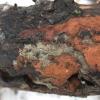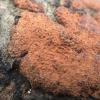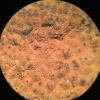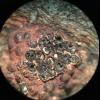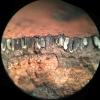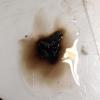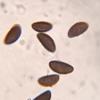
14-11-2025 16:26
 Marian Jagers
Marian Jagers
Hello everyone, On dead wood of Cytisus scoparius

14-11-2025 18:31
 Lothar Krieglsteiner
Lothar Krieglsteiner
Hello,can somebody provide me with a file of:Rothe

12-11-2025 09:25
 Viktorie Halasu
Viktorie Halasu
Hello, I need help with a pale terrestric Pseudom

11-11-2025 20:16
Bohan JiaHi, lastly I have found these tiny yellow decayin

09-11-2025 13:20
Hello.A tiny ascomycete, appearing as erupting gra

08-11-2025 00:29
 Francois Guay
Francois Guay
I found this species in Quebec, Canada, on herbace
Hypoxylon sp. with dark umber extractable pigments
Ethan Crenson,
26-01-2020 00:07
Last week in New York City I found this Hypoxylon with brick red surface pigments, fairly apparent perithecial mounds and dark umber KOH-extractable pigments. The ostioles are lower than the surface of the stroma. Perithecia are obovoid. There are yellow-brown granules between the perithecia—very apparent in horizontal section, but quite inconspicuous in vertical section. Unfortunately it must be quite old because I could find no asci (there were insect eggs inside some of the perithecia). Spores are brown/dark brown, germ slit is on the convex side and runs full spore-length, 9.5-13 x 5-5.5µm. Is it possible to know what Hypoxylon this is with the information I have provided?
Thanks,
Ethan
Jacques Fournier,
26-01-2020 09:23

Re : Hypoxylon sp. with dark umber extractable pigments
Hi Ethan,
Interesting!
Hypoxylon spp with orange surface usually have somewhat orange pigments in KOH. The association with brown pigments is most unusual and I have no idea to propose. Does the brown pigment appear rapidly after contact with KOH (1-5 min) or later? A succession of colors may occur with time, which may be informative.
The reaction of the perisore to KOH and its ornamentation are essential features, but difficult to implement with old weathered ascospores like those of your specimen, they may have already lost their perispore and thus give false negative reaction.
This Hypoxylon deserves to be found again in better condition to be better documented.
Good luck!
Jacques
Ethan Crenson,
27-01-2020 17:10
Re : Hypoxylon sp. with dark umber extractable pigments
Hi Jacques,
Thank you for your input. I do hope to find this Hypoxylon again in better condition.
I find that the brown pigment does emerge fairly quickly. But maybe I am a little impatient, because usually I grind the tissue with the edge of the knife in the KOH. Would it yield more reliable results if I left the tissue intact and waited? In Ju and Rogers there are notes about certain species that produce different pigments in age than they do when fresh. However, I don't think the common red effuse Hypoxylons that we usually find are among them... apart from Hypomontagnella submonticulosa which produces no colors in age.
Ethan
